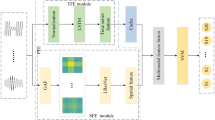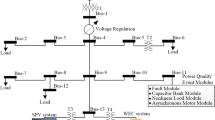Abstract
Automated and accurate detection of power quality (PQ) events is important from the point of view of safety as well as maintaining the reliability of the power transmission and distribution network. However, detection of multiple PQ events in a noisy environment is challenging task. Another important issue is the choice of meaningful features that can directly influence the accuracy of PQ detection. Considering these two aforesaid facts, this paper presents a novel framework for automated classification of PQ signals in a noisy environment employing cross Stockwell Transform (XST). The XST proposed in this paper has better noise suppression capability compared to conventional Stockwell Transform. Here, XST was used to convert 1D PQ signals to 2D time–frequency (T–F) images. To improve the accuracy of PQ detection, an automated feature extraction method employing deep learning is implemented in this work. The noise free T–F images obtained using XST were fed as inputs to several pre-trained convolutional neural networks (CNNs) for deep feature extraction. Transfer learning technique was implemented to reduce the computational cost. The extracted deep features were further undergone selection using one-way analysis of variance test followed by false discovery rate correction. The statistically significant deep features were subsequently fed to three benchmark machine learning classifiers for classification of PQ signals. In addition, tests were also carried out on real-life PQ signals to verify the practicability of the proposed framework. Investigations revealed that the proposed method returned mean accuracy of 99.72% and 96.45% for classification of simulated and real-life PQ signals, respectively.











Similar content being viewed by others
Data availability
Data can be made available upon request.
References
Chiam DH, Lim KH, Law KH (2023) LSTM power quality disturbance classification with wavelets and attention mechanism. Electr Eng 105:259–266
Ekici S, Ucar F, Dandil B (2021) Power quality event classification using optimized Bayesian convolutional neural networks. Electr Eng 103:67–77
Borges FAS, Fernandes RAS, Silva IN, Silva CBS (2016) Feature extraction and power quality disturbances classification using smart meters signals. IEEE Trans Industr Inf 12(2):824–833
Akbarpour A, Nafar M, Simab M (2022) Multiple power quality disturbances detection and classification with fluctuations of amplitude and decision tree algorithm. Electr Eng 104:2333–2343
Zhong T, Zhang S, Cai G, Huang N (2018) Power-quality disturbance recognition based on time-frequency analysis and decision tree. IET Gener Transm Distrib 12(18):4153–4162
Masoum M, Jamali S, Ghaffarzadeh N (2010) Detection and classification of power quality disturbances using discrete wavelet transform and wavelet networks. IET Sci Meas Technol 4(4):193–205
Samanta IS, Rout PK, Mishra S (2021) Feature extraction and power quality event classification using curvelet transform and optimized extreme learning machine. Electr Eng 103:1–16
Zhang M, Li K, Hu Y (2012) Classification of power quality disturbances using wavelet packet energy and multiclass support vector machine. Emerald COMPEL 31(2):424–442
Thirumala K, Prasad MS, Jain T, Umarikar AC (2018) Tunable-Q wavelet transform and dual multiclass SVM for online automatic detection of power quality disturbances. IEEE Trans Smart Grid 9(4):3018–3028
Thirumala K, Umarikar AC, Jain T (2015) Estimation of single-phase and three-phase power-quality indices using empirical wavelet transform. IEEE Trans Power Delivery 30(1):445–454
Biswal M, Dash PK (2012) Estimation of time-varying power quality indices with an adaptive window-based fast generalized S-transform. IET Sci Meas Technol 6(4):189–197
He S, Li K, Zhang M (2013) A real-time power quality disturbances classification using hybrid method based on S-transform and dynamics. IEEE Trans Instrum Meas 62(9):2465–2475
Bhende CN, Mishra S, Panigrahi BK (2008) Detection and classification of power quality disturbances using S-transform and modular neural network. Electr Power Syst Res 78(1):122–128
Hasheminejad S, Esmaeili S, Jazebi S (2012) Power quality disturbance classification using S-transform and hidden Markov model. Electr Power Compon Syst 40(10):1160–1182
Cui C, Duan Y, Hu H, Wang L, Liu Q (2022) Detection and classification of multiple power quality disturbances using stockwell transform and deep learning. IEEE Trans Instrum Meas 71:1–12
Chatterjee S, Ray Choudhury N, Bose R (2017) Detection of epileptic seizure and seizure-free EEG signals employing generalized S-transform. IET Sci, Meas Technol 11(7):847–855
Reddy MV, Sodhi R (2018) A modified S-transform and random forests-based power quality assessment framework. IEEE Trans Instrum Meas 67(1):78–89
Nandi K, Das AK, Ghosh R, Dalai S, Chatterjee B (2021) Hyperbolic window S-transform aided deep neural network model-based power quality monitoring framework in electrical power system. IEEE Sens J 21(12):13695–13703
Goh HH, Liao L, Zhang D, Dai W, Lim CS, Kurniawan TA, Goh KC (2022) An integrated approach improved fast S-transform and SVD noise reduction for classification of power quality disruptions in noisy environments. Electr Power Compon Syst 50(14–15):868–885
Reddya MJB, Raghupathya RK, Venkatesha KP, Mohanta DK (2013) Power quality analysis using discrete orthogonal S-transform (DOST). Digit Signal Process 23(2):616–626
Chatterjee S, Dalai S, Chakravorti S, Chatterjee B (2018) Use of chirp excitations for frequency domain spectroscopy measurement of oil-paper insulation. IEEE Trans Dielectr Electr Insul 25(2):1103–1111
Das AK, Chatterjee S, Dalai S, Chatterjee B (2021) Cross spectrum aided surface condition assessment of metal oxide surge arrester employing convolutional neural network. IEEE Trans Dielectr Electr Insul 28(6):2134–2143
Modak S, Roy SS, Bose R, Chatterjee S (2021) Focal epileptogenic area recognition employing cross EEG rhythm spectrum images and convolutional neural network. IEEE Sens J 21(20):23335–23343
IEEE 1159-2009 (2009) IEEE recommended practice for monitoring electric power quality
Stockwell RG, Mansinha L, Lowe RP (1996) Localization of the complex spectrum: the S transform. IEEE Trans Signal Process 44(4):998–1001
Das AK, Dey D, Chatterjee B, Dalai S (2021) A transfer learning approach to sense the degree of surface pollution for metal oxide surge arrester employing infrared thermal imaging. IEEE Sens J 21(15):16961–16968
Chaudhary S, Taran S, Bajaj V, Sengur A (2019) Convolutional neural network based approach towards motor imagery tasks EEG signals classification. IEEE Sens J 19(12):4494–4500
Celika Y, Talob M, Yildirim O, Karabatak M et al (2020) Automated invasive ductal carcinoma detection based using deep transfer learning with whole-slide images. Pattern Recognit Lett 133:232–239
Krizhevsky A, Sutskever L, Hinton GE (2012) ImageNet classification with deep convolutional neural networks. NIPS :1106–1114
Karen S, Zisserman A (2014) Very deep convolutional networks for large-scale image recognition. arXiv preprint arXiv: 1409.1556
He K, et al (2016) Deep residual learning for image recognition. In: Proceedings of the IEEE Conference on Computer Vision and Pattern Recognition (CVPR)
Christian S, et al (2015) Going deeper with convolutions. In: Proceedings of the IEEE Conference on Computer Vision and Pattern Recognition (CVPR)
Zhang T, Chen W, Li M (2017) AR based quadratic feature extraction in the VMD domain for the automated seizure detection of EEG using random forest classifier. Biomed Signal Process Control 31:550–559
Vapnik VN (2000) The nature of statistical learning theory. Springer, Berlin
Cover TM, Hart PE (1967) Nearest neighbor pattern classification. IEEE Trans Inf Theory 13(1):21–27
Florencias-Oliveros O, Espinosa-Gavira MJ, de la Rosa J-JG, Agüera-Pérez A, Palomares-Salas JC, Sierra-Fernández JM (2017) Real-life power quality sags. IEEE Dataport. https://doi.org/10.21227/H2K88D
Florencias-Oliveros O, Espinosa-Gavira MJ, de la Rosa JJG, Agüera-Pérez A, Salas JCP, Sierra-Fernández JM (2017) Real-life power quality transients. IEEE Dataport. https://doi.org/10.21227/H2Q30W
DOE Disturbance Library. US Dept. Energy Electr. Power Res. Inst., Orlando, FL, USA. http://pqmon.epri.com/disturbance_library/see_all.html
Mishra S, Bhende CN, Panigrahi BK (2008) Detection and classification of power quality disturbances using S-transform and probabilistic neural network. IEEE Trans Power Del 23(1):280–287
Behera HS, Dash PK, Biswal B (2010) Power quality time series data mining using S-transform and fuzzy expert system. Appl Soft Comput 10(3):945–955
Fu L, Yan K, Zhu T (2022) PowerCog: a practical method for recognizing power quality disturbances accurately in a noisy environment. IEEE Trans Ind Informat 18(5):3105–3113
Reddy MV, Sodhi R (2016) A rule-based S-transform and AdaBoost based approach for power quality assessment. Electr Power Syst Res 134:66–79
Yilmaz A, Küçüker A, Bayrak G, Ertekin D, Shafie-Khah M, Guerrero JM (2022) An improved automated PQD classification method for distributed generators with hybrid SVM-based approach using un-decimated wavelet transform. Int J Electr Power Energy Syst 136:107763
Cai K, Cao W, Aarniovuori L, Pang H, Lin Y, Li G (2019) Classification of power quality disturbances using Wigner-Ville distribution and deep convolutional neural networks. IEEE Access 7:119099–119109
Zhong T, Zhang S, Cai G, Li Y, Yang B, Chen Y (2019) Power quality disturbance recognition based on multiresolution S-transform and decision tree. IEEE Access 7:88380–88392
Funding
There is no funding provided to carry out the research work.
Author information
Authors and Affiliations
Contributions
AC: Paper writing. SC: Conceptualization. RM: Editing.
Corresponding author
Ethics declarations
Conflict of interest
The authors declare no conflict of interest.
Ethical approval
Not applicable.
Additional information
Publisher's Note
Springer Nature remains neutral with regard to jurisdictional claims in published maps and institutional affiliations.
Rights and permissions
Springer Nature or its licensor (e.g. a society or other partner) holds exclusive rights to this article under a publishing agreement with the author(s) or other rightsholder(s); author self-archiving of the accepted manuscript version of this article is solely governed by the terms of such publishing agreement and applicable law.
About this article
Cite this article
Chakraborty, A., Chatterjee, S. & Mandal, R. Power quality recognition in noisy environment employing deep feature extraction from cross stockwell spectrum time–frequency images. Electr Eng 106, 443–458 (2024). https://doi.org/10.1007/s00202-023-01995-0
Received:
Accepted:
Published:
Issue Date:
DOI: https://doi.org/10.1007/s00202-023-01995-0




